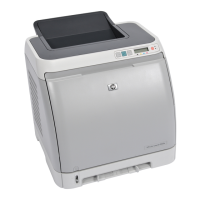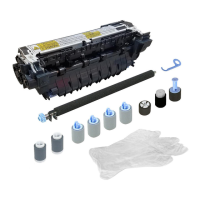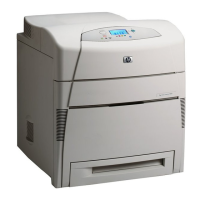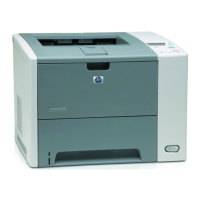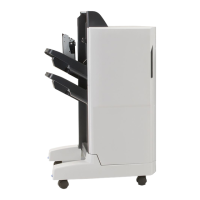The following three protective components prevent the fuser heater from excessive temperatures:
◦
DC controller
◦
Fuser heater safety circuit
◦
Thermoswitch
●
DC controller: The DC controller monitors the detected temperature of the thermistors. The DC
controller deactivates the FUSER HEATER CONTROL signal and releases the relays (RL101 and
RL102) to interrupt power supply to the fuser heater when it detects an excessive temperature.
●
Fuser heater safety circuit: The fuser heater safety circuit monitors the detected temperature of
the thermistors. The fuser heater safety circuit deactivates the FUSER HEATER CONTROL signal
and releases the relays (RL101 and RL102) to interrupt power supply to the fuser heater when it
detects an excessive temperature.
●
Thermoswitch: If the temperature of the fuser heater is abnormally high, the contact of the
thermoswitch breaks to interrupt power supply to the fuser heater.
Fuser failure detection
The DC controller determines if the fuser functions properly. The DC controller determines a fuser
failure, interrupts power supply to the fuser heater and notifies the formatter of a failure status when it
encounters any of following conditions:
●
Abnormal temperature rise
◦
The main thermistor does not detect 15°C (59°F) or higher within a specified period from
when the fuser heater is turned on.
◦
The main thermistor does not detect 100°C (212°F) or higher within a specified period from
when the fuser heater is turned on.
◦
The main thermistor does not detect targeted temperature minus 5°C (41°F) within a specified
period from when the fuser heater is turned on.
●
Abnormally low temperature
◦
The main thermistor detects 49°C (120.2°F) or lower continuously for a specified period after
it once detects 100°C (212°F) or higher.
◦
The main thermistor detects targeted temperature minus specified degrees or lower
continuously for a specified period after the TOP signal for the first page is output.
◦
The sub thermistor detects 49°C (120.2°F) or lower continuously for a specified period after it
once detects 100°C (212°F) or higher.
●
Abnormally high temperature
◦
The main thermistor detects 255°C (491°F) or higher.
◦
The sub thermistor detects 285°C (545°F)or higher.
14 Chapter 1 Theory of operation ENWW

